This post has been republished via RSS; it originally appeared at: Channel 9.
For the next couple months we're going to revisit Build 2017, each post focusing on different aspects and technologies presented. Not every session will be listed, just a select set, hopefully enough to wet your appetite. All the on-demand sessions can be found and the Channel 9 Build event site.
Cortana, Machine Learning and Artificial Intelligence was a major theme of Build. Of the 46'ish sessions here a select 26 sessions.
Build Revisited Table Of Contents
- Pre-Recorded Sessions
- .Net, XAML, Visual Studio
- Azure
- Windows 10
- AI/ML (This Post)
- Bots
- Office
- ALM & DevOps
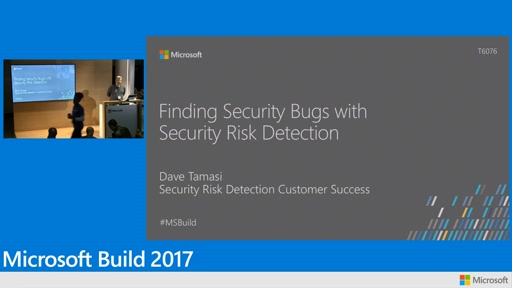
- Microsoft Security Risk Detection – Artificial Intelligence Powered Risk Detection for…
Microsoft Security Risk Detection, formerly “Project Springfield,” packages pioneering artificial intelligence into a scalable cloud service that helps you find issues in code you build, code you buy, or code you are moving to the cloud. You will see how Security Risk Detection fits into these scenarios. You will learn about the issues Security Risk Detection can help you find and actions you can take. Finally, watch to the end for a new frontier in Microsoft’s journey to help developers everywhere be more secure.
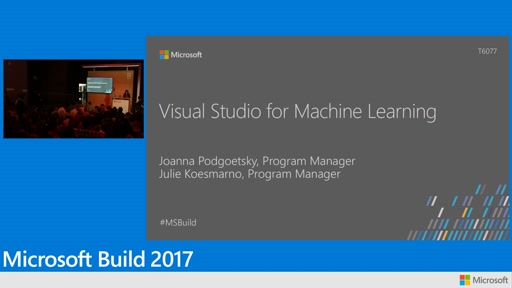
- Using Visual Studio for Machine Learning
Whether it is building a model for online product recommendation, or developing a project using Microsoft SQL Server 2016 with R, where you need to develop both the models, and the stored procedure, Visual Studio enables both developers and data scientists to work together to build your next generation intelligent apps and services. All the tooling you need to analyze, build models, and create smart apps, including: Python Tools for Visual Studio and R Tools for Visual Studio. Join us in this this session, as we show you how Visual Studio can be used to do data science, and help you create the next intelligent application!
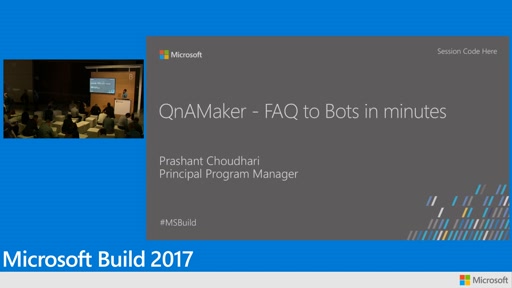
- Distill information into conversational, easy to navigate answers with Microsoft Cognitive…
Microsoft Cognitive Services QnA Maker is an easy-to-use API that trains AI to respond to users’ questions in a more natural, conversational way. QnA Maker is a question and answer service with a graphical user interface—meaning you don’t need to be a developer to train, manage, and use it for a wide range of solutions.
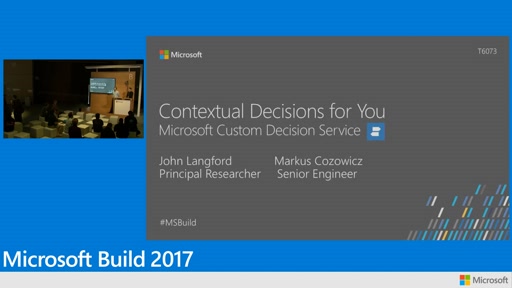
- Contextual decisions for you
Do you want to recommend a news story? Have your interface optimize for its user? Maybe you just wish that when you used machine learning it actually worked in deployment? In all of these cases, you want to make decisions amongst a set of actions based on a context to optimize an outcome. Doing this consistently and effectively requires a system that combines exploration and learning together to adaptively discover performant policies. We have created that system and deployed it several ways with great results. That system can now be used by you, most easily for simple content personalization, but more generally in any system where you have many repeated events where context matters in making a decision and the quality of that decision can be evaluated.
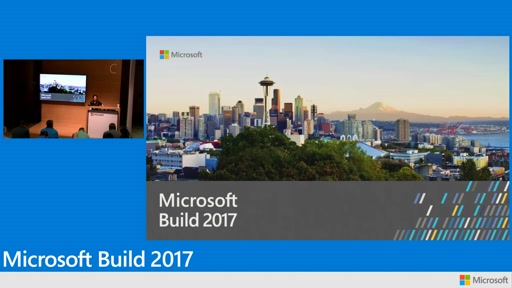
- How to do predictive modeling using R and SQL Server Machine Learning Services
Learn how to use R scripts from T-SQL to perform training and scoring and leverage parallelism and streaming capabilities to get better performance.
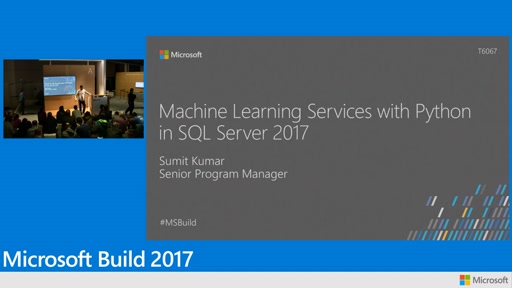
- Built-in machine learning in Microsoft SQL Server 2017 with Python
Machine learning services in SQL Server 2017 provides Python support for in-database machine learning, now. In this session we show the basics of how to run Python code in SQL Server. We then discuss how any app that can talk to SQL Server can get intelligence from machine learning models running in SQL Server. We showcase an app that uses a Python-based deep learning model built and deployed in SQL Server. The model leverages an open source deep learning framework running with SQL Server and utilizes GPU for boosting model training performance.
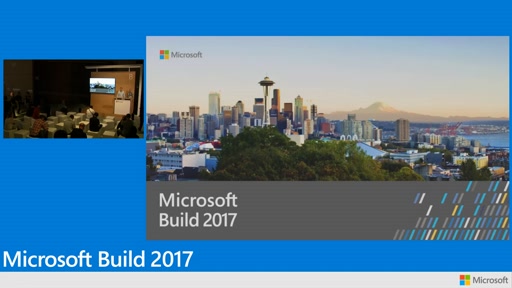
- Leveraging Cortana user knowledge to personalize your Cortana skill
As a personal assistant, Cortana learns about each user and develops a deep understanding of their preferences, habits, and context. This session shows you step-by-step how to use the Cortana Skills Kit to leverage Cortana user knowledge to create highly personalized skills that drive deep user engagement.
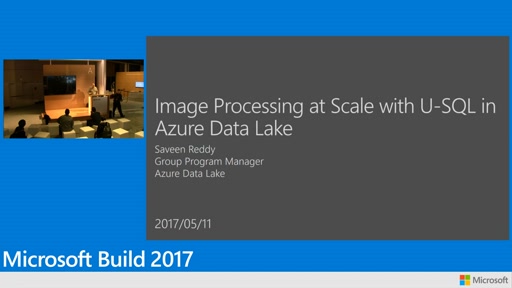
- Image processing at scale using U-SQL in Azure Data Lake
Making use of cognitive capabilities such as Image OCR or Sentiment Analysis of text is straightforward with small datasets of a few terabytes. But, at the scale of hundreds of terabytes or even a petabyte, you need a different approach to that can massively scale out *AND* be simple to build. Azure Data Lake offers a straightforward way of programming using .NET code against these massive Petabyte-scale datasets without the need to become a deep expert in distributed computing, big data technologies, or machine learning.
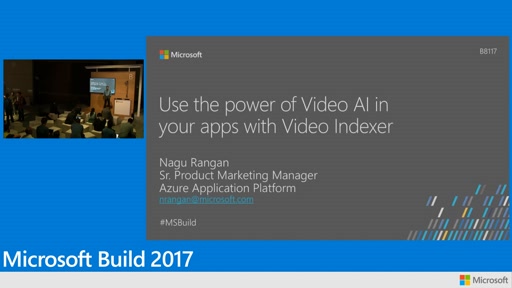
- Use the power of Video AI in your apps with Video Indexer
Got video? We can help you turn your video into insights and transform your business. Join us as we show you are latest video intelligence capabilities.
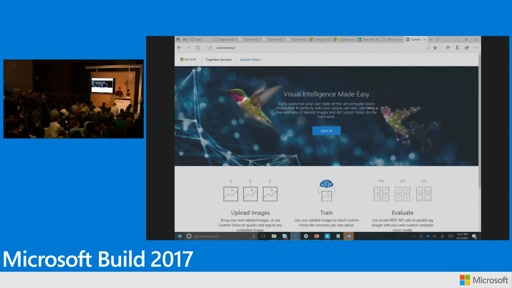
- Custom Vision from Cognitive Services: easily build a custom image classifier
Custom Vision is a tool for easily building an image classifier to recognize content you care about. In a few minutes, you can train a classifier and deploy it to an API endpoint. Using suggestions from the software, it is easy to improve the quality of your classifier.
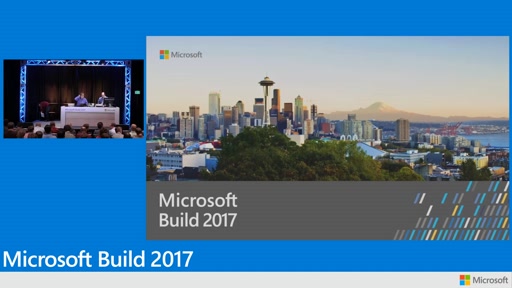
- Using Microsoft Cognitive Services to bring the power of speech recognition to your apps
Learn about Microsoft Cognitive Services Speech APIs - Bing Speech, Customer Speech Service and Speaker Recognition - and how they recognize audio, speech and individual speakers to bring the power of speech to your apps.
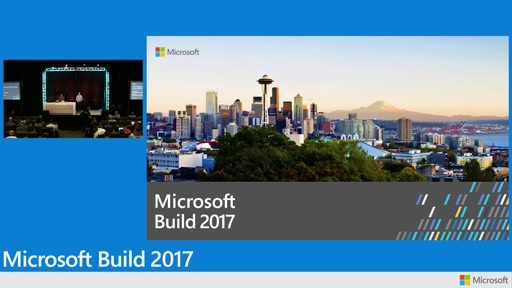
- Build intelligence into your business apps with ease using Bing APIs in Microsoft…
The Bing API's in Cognitive Services let you bring the intelligence and knowledge of the planet to your app in just a few lines of code. Join us to learn about the Bing Search APIs, get a sneak peek at the next version of “Search” APIs, and learn how you can leverage these services in conjunction with the Microsoft Bot Framework to build an intelligent assistant. See useful demos, experience the simplicity of calling this code, and get ideas for adding this functionality to your own applications.
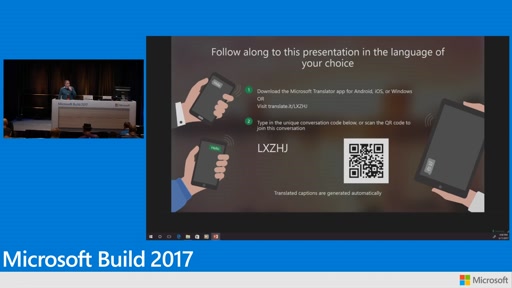
- How Microsoft Cognitive Services can help your apps communicate with people
Microsoft Cognitive Services Language APIs - Bing Spell Check, Language Understanding, Linguistic Analysis, Text Analytics, Translator and Web LM - can enable your apps to understand language and communicate with people.
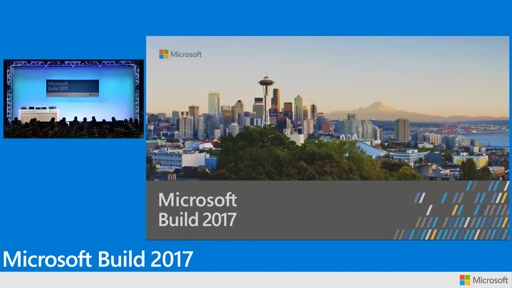
- How to serve AI with data: The future of the Microsoft Data Platform
The cloud is truly becoming the “brain” for our connected planet. You’re not just running algorithms in the cloud, rather you’re connecting that with data from sensors from around the world. By bringing data into the cloud, you can integrate all of the information, apply machine learning and AI on top of that, and deliver apps that are continuously learning and evolving in the cloud. Consequently, the devices and applications connected to cloud are learning and becoming increasingly intelligent. Please join us on a journey through the core new patterns that are emerging as we bring advanced intelligence, the cloud, IoT, and big data together.
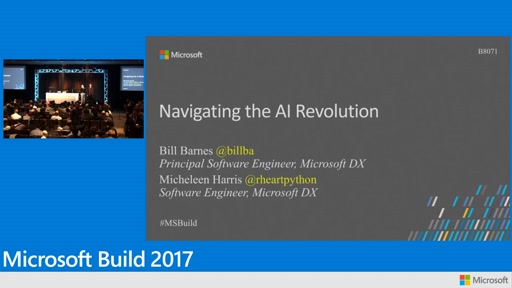
- Navigating the AI Revolution
Learn about the new software landscape, how Microsoft makes it easy to add AI to your applications, and how to thrive as a developer in a world of machine learning, neural networks, and data science.
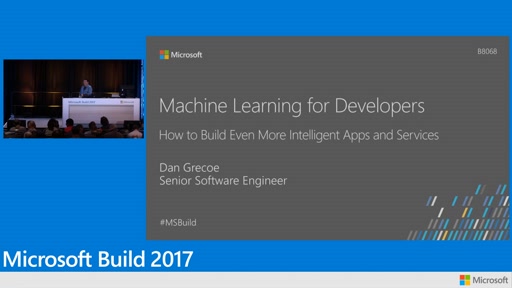
- Machine Learning for developers, how to build even more intelligent apps and services
In this session we explain some of the different machine learning offerings such as Azure Machine Learning, SQL Server R Services, Data Science Virtual Machine, Cognitive Services and Cognitive Toolkit, and Azure Data Lake Analytics from Microsoft through a few comprehensive end-to-end examples that encompass as applicable: problem detection, algorithm selection, machine learning model creation and deployment and consumption of the machine learning model. The session is delivered by an engineer, and it's intended for engineers, so he does not delve into a deep understanding of complex mathematical models behind machine learning, but instead focuses on the concepts of machine learning and resources available to demystify machine learning using Microsoft Azure.
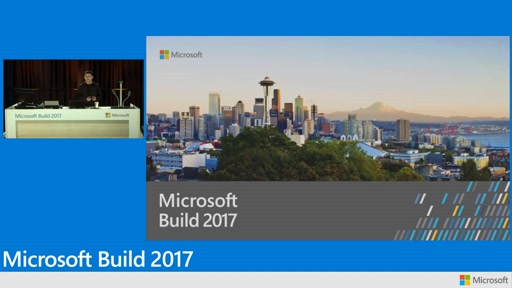
- How to run AI at Petabyte Scale with cognitive functions in the Azure Data Lake
In this session, learn how you can use Azure Data Lake (ADL) for doing Big Cognition on raw customer support data. Learn how you can use ADL to perform key phrase extraction, sentiment analysis, and how you can use R/Python scripts for support volume forecasting. In addition, learn how you can use federated queries in ADL with Azure SQL Database. Discover how you can pull all these insights into an Azure SQL Data Warehouse, and using Azure Analysis Services to enable interactive analysis of the processed data. Join us for this exciting session as we show how you can develop intelligent applications by using the insights derived from processing massive Petabyte-scale datasets.
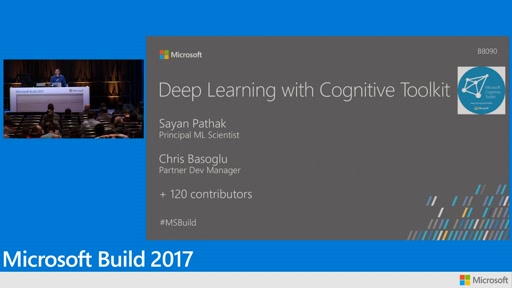
- Deep learning with Microsoft Cognitive Toolkit
Explore the toolkit we use to build AI tools and train your own deep learning algorithms to learn like the human brain.
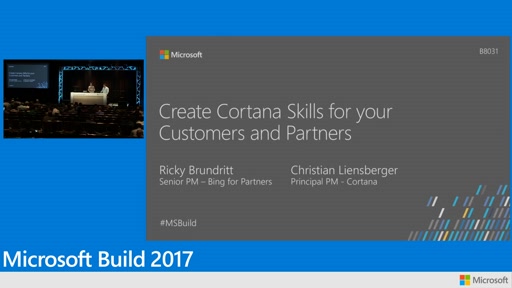
- Create Cortana skills for your customers, partners, and work force
The Cortana Skills Kit opens up new opportunities for businesses to reduce costs, improve customer service, and drive revenue. This session shows how you can combine the Cortana Skills Kit together with Microsoft AI services in B2C, B2B, and line-of-business scenarios.
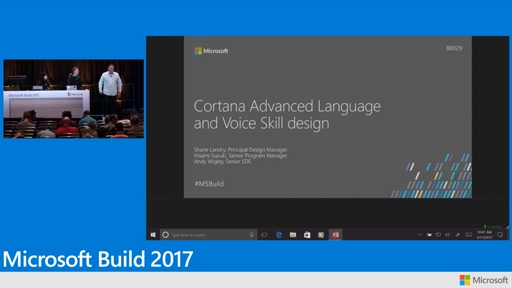
- Cortana advanced language and voice skill design
The Cortana Skills Kit opens the world of voice-driven experiences to every developer, but developing skills your users will love requires a deeper understanding of this voice-first paradigm. This session covers design principles for voice-first and voice-only experiences, how to design and implement robust language understanding, and shows you how to implement these using the Cortana Skills Kit.
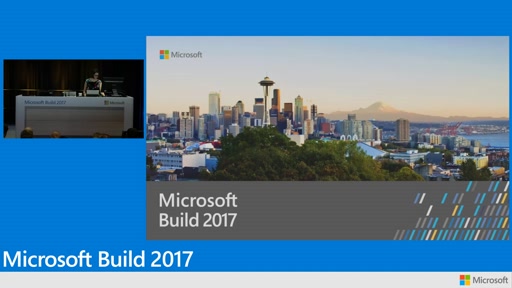
- Computer vision made easy: From pre-trained models to Custom Vision, Microsoft Cognitive…
Learn about Computer Vision APIs and tools from Microsoft, and how you can embed them in your software solutions. There will be a deep dive into the new Custom Vision service from Microsoft Cognitive Services, a tool for easily building, deploying, and improving an image classifier. We will also disambiguate how to find the right tool for the job across our APIs, services, Cognitive Toolkit. There will be announcements and demos across image classification, face and emotion recognition, OCR, and video services. See powerful demos, experience the simplicity of calling this code, and get ideas for adding this functionality to your own applications.
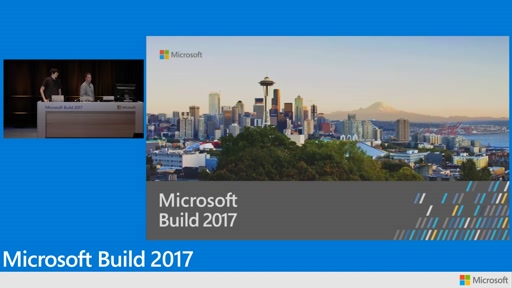
- How to build in-app analytics with Azure Data Services, an Xbox case study
What are some of the largest games and apps doing to understand user behavior and deliver up to the minute insights for product and business planning? How are some applications using advanced analytics and machine learning to deliver ground-breaking experiences? Learn how games companies like Xbox Studios are using Azure services including SQL Data Warehouse, Analysis Services, and Microsoft Power BI to drive great in-game experiences and determine where to take their products. See how you can use these patterns to drive deeper engagement in your app and gain insights into user behavior.
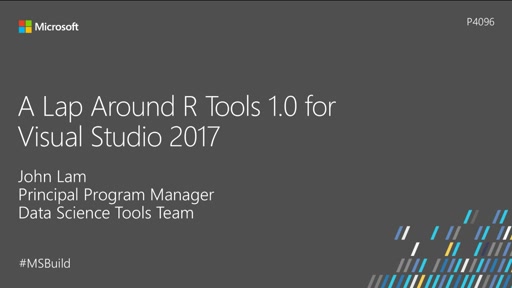
- A lap around R Tools 1.0 for Visual Studio 2017
R Tools for Visual Studio is a new, open source and free tool for R users built on top of the powerful Visual Studio IDE. In this talk, we take you on a tour of its features and show how they can help you be a more productive R user. We look at: integrated debugging support; variable/data frame visualization; plotting and help integration; using the Editor and REPL in concert with each other; RMarkdown and Shiny integration using Microsoft Excel and SQL Server; Extensions and source control. We also demo our R remoting feature that allows developers to execute R code on SQL Server.
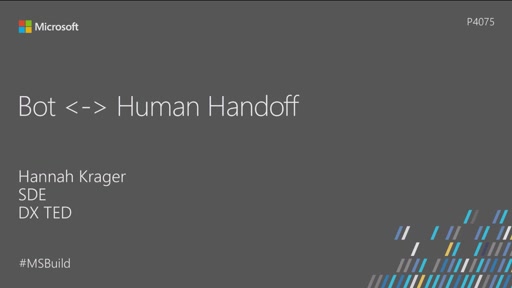
- Bot Human Handoff
Bots can’t replace our human agents, but they can augment the customer service experience. This session explores how we can use a bot to initiate a conversation with a customer, and then hand off context to a human agent.
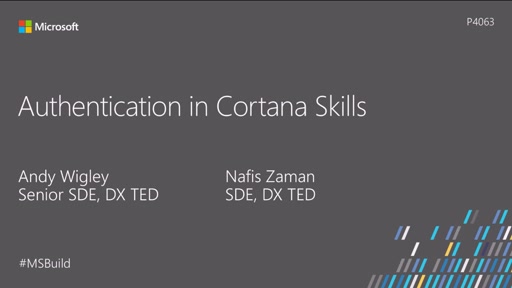
- Authentication in Cortana Skills
Cortana Skills can make calls to other services that require authentication, such as the Microsoft Graph. The easiest way to implement this for a service that requires OAuth 2.0 authentication is to configure a Connected Service for your skill and let Cortana manage the authentication token which is passed to your skill on invocation. Alternatively, you can manage the authentication entirely within your skills service which requires more work but gives greater flexibility. In this session, we’ll walk through how to configure a Connected Service and how to access the authentication tokens within your skill service to make authenticated calls, and we’ll cover how to implement skill-managed authentication.
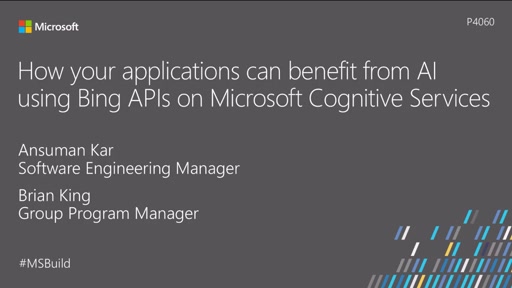
- How your applications can benefit from AI using Bing APIs on Microsoft Cognitive Services
Bing APIs on Cognitive Services provides a wealth of AI capabilities for you to use in your enterprise or mobile applications. Learn how easy it is to incorporate knowledge and intelligence into your applications and take your business to the next level.

